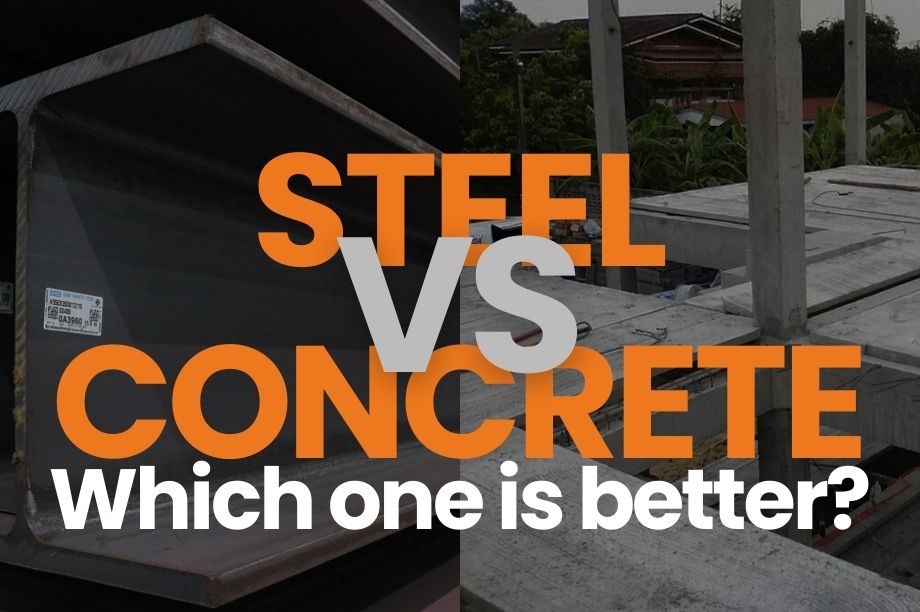Steel vs. Concrete Structures A tough decision but which one is better
Perd Surasak • 15 Apr 2025

When it comes to building a house, one of the most challenging decisions for many homeowners is choosing the right type of structural system. Should you opt for the widely used concrete structure, or embrace the rising trend of steel structures?
Each has its own cost implications, construction timelines, and technical considerations. Despite these differences, both ultimately result in a completed structure—be it a house or a building.
The truth is, both structural systems are capable of producing strong and durable buildings. However, they each come with their own set of advantages and disadvantages, which must be weighed carefully. Choosing solely based on one factor could lead to suboptimal outcomes.
This article aims to explore the key differences between these two popular construction methods, helping you make an informed decision for the building you love.
Steel Structures
In recent years, steel structures have gained significant traction in the construction industry. Their growing popularity stems from the versatility and efficiency steel offers in residential and commercial applications.
Steel provides a wide range of options when it comes to construction materials, as it comes in various types and grades. This flexibility allows builders to tailor the structure to meet specific design and performance requirements.
Thanks to advances in construction technology, it is now possible to build entire homes or buildings using steel components alone—without the need for supplemental materials. Steel elements can be fabricated into beams, columns, floor systems, roofing structures, and even walls and floors.
Common steel types used in these structures include H-beams (wide flange beams), I-beams, angle bars, channel steels, square tubes, and flat tubes. Each type is selected based on the structural needs and mechanical properties required.
A frequently used component is the H-beam, known for its high load-bearing capacity and durability. These characteristics make it ideal for use in large-scale structures, such as residential buildings, industrial warehouses, or commercial projects.
Another advantage of steel structures is their relatively light weight compared to concrete. This often translates into reduced costs for foundation and piling work—saving both time and labor expenses.
It’s important to note, however, that H-beams are sometimes confused with I-beams due to their similar appearance. While they may look alike, they serve different structural purposes and should be used accordingly.
Furthermore, steel is a prefabricated material produced in a controlled factory environment. This ensures higher quality and consistency when compared to on-site mixed concrete or timber, which are subject to more variability.
Steel construction is also significantly faster than reinforced concrete, potentially cutting project timelines in half.
In summary, while steel structures may not yet be as widespread as concrete in residential construction, they offer comparable—if not superior—strength and durability. That said, the initial structural cost of steel is often higher, particularly in the columns and beams—typically about 30% more than concrete.
However, this does not necessarily mean that total construction costs are always higher. When factoring in reduced construction time, fewer labor requirements, and less material waste, steel structures can be quite cost-effective—especially in today’s market where skilled labor is increasingly scarce.
Concrete Structures
Concrete structures have long been the standard in the construction industry and remain a popular choice today—largely due to their affordability and availability.
Concrete is made from a mixture of cement, stone, gravel, sand, and water. Its composition makes it easy to source and relatively inexpensive compared to other structural materials.
However, this mix of components requires skilled labor to ensure the proper ratios and mixing techniques are followed. If not done correctly, the resulting structure may fail to meet safety and durability standards.
To address this, modern concrete structures commonly incorporate reinforced steel, forming what is known as Reinforced Concrete (RC) or in Thai, ค.ส.ล. (K.S.L.).
Concrete has excellent compressive strength but relatively low tensile strength. By adding steel reinforcement, the material gains the ability to handle tensile forces as well—making it far more suitable for structural applications.
For residential buildings and general-purpose structures, reinforced concrete can typically bear loads of 200–400 kg/m².
There are two main types of steel used in reinforced concrete:
- Round Bars (RB) – smooth steel rods.
- Deformed Bars (DB) – ridged steel bars for better bonding with concrete.
Over the years, the quality and reliability of reinforced concrete structures have improved significantly. With proper formwork and mixing, concrete can now be molded into a wide variety of structural shapes and styles.
Nonetheless, concrete construction still requires careful execution. Critical steps such as pouring, curing, and steel reinforcement placement must be done meticulously to ensure structural integrity.
In conclusion, most concrete structures today are, in fact, reinforced with steel—demonstrating the indispensable role steel plays in modern construction. In many ways, steel is the unsung hero of the building world.
Which Structure Is Better?
After reviewing the details above, it becomes clear that both steel and concrete structures offer unique advantages and limitations. Therefore, it would be inappropriate to declare one as categorically superior to the other.
The more important question is: Which structure best suits your specific use case?
Considerations should include the type of project, construction timeline, budget, and most importantly, the expertise of the construction team. Even the best materials will underperform if installed incorrectly or in an unsuitable environment.
Likewise, choosing contractors who specialize in the chosen structural system is essential. Some professionals may be more skilled in one method than the other.
That said, if I were to offer a personal opinion—steel structures may have a slight edge in today’s context. With labor costs rising steadily, the efficiency, speed, and consistency of steel make it a compelling choice.
In recent years, I’ve had the opportunity to work on multiple steel structure projects, and the results have consistently exceeded expectations—in terms of both quality and timeline.
Connect with us to bring your vision to Life.
